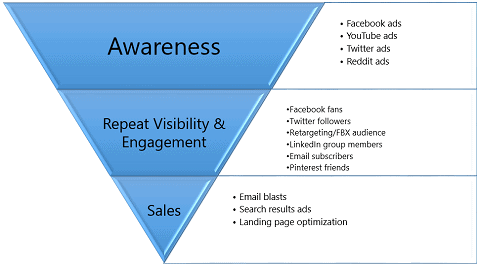Your social media accounts are one of the most important aspects of your overall marketing strategy. This article defines the social media marketing funnel stages you need to know to create effective funnels.
Since the launch of Facebook, social media has taken up an increasingly important role in marketing strategy. Today, the many social media platforms offer you the opportunity to interact directly with your customers. You can use them to advertise new products and to handle customer issues directly.
Simply put, they’re a vital marketing tool. You could even call them this generation’s word of mouth. People head to social media whenever they have an interaction with a company. They’ll share your content with others when they’re happy with your service. But they also won’t hesitate to let their friends know when they’re not.
When handled correctly, social media allows you to increase brand awareness. It can also help you to increase your sales. However, that requires understanding of how to create a social media marketing funnel.
Having social media pages isn’t enough. Your goal is to turn your followers into active customers. For that, you need to know how to create a marketing funnel that leads to your social media pages generating revenue for your business.

What is a Digital Marketing Funnel?
Think of a digital marketing funnel as a business process. It’s what you use to track every stage of your customer’s journey. As a result, it has to cover everything from the moment you make contact with the customer to the eventual buying decision and beyond.
Your digital marketing funnel has two purposes. The first is to figure out what’s involved with each stage your customers go through before making a buying decision. This can include things such as learning about a company, researching it, and any direct interactions they have with it.
The second purpose is to figure out how to influence the customer at each stage. Your marketing funnel must create a constant positive impression. This keeps potential customers engaged throughout the journey. This leads to them moving through the stages until they eventually make a purchase. Influencing techniques may include phone calls after an interaction or positive online reviews.
Generally speaking, most marketers agree that a digital marketing funnel has six key stages:
- Awareness – When the customer first hears about the company.
- Consideration – The customer compares the company against others that offer similar services.
- Preference – When the customer decides your company is right for them.
- Action – This is usually when the buyer makes a purchase or takes an otherwise positive action.
- Loyalty – You’ve delivered a good service and the customer makes the decision to keep coming back to you.
- Advocacy – The final and most desirable stage. The customer is no longer just an active purchaser. They’re also encouraging other people to buy from you.
Ideally, your social media marketing funnel will turn your customers into brand advocates. This makes them a marketing force in their own right, as well as active customers.
Now you need to know how to create a marketing funnel. There are five key steps to follow.
Step #1 – Building the Funnel
Before you can figure out how to influence your customers, you must first have the structure of a funnel to push them through.
With social media, your first funnel stage defines how the customer becomes aware of you. You can rely on other customers to organically share your content. But there are some more active steps to take as well. For example, you could use Facebook ads that trigger for specific audiences that you believe have an interest in your product.
The key is engaging your audience and getting them interested. Each subsequent stage focuses on how to build upon that interest. The funnel’s end goal is to take the customer from general awareness of the product, through to want, and eventually need.
A typical social media funnel may look something like this:

Figure 1 – https://www.socialmediaexaminer.com/social-marketing-sales-funnel/
This is a simplified funnel but it shows you the general structure. First, you make some form of contact with the customer. Online adverts generally serve that purpose in a social media marketing funnel. You then reinforce the message and maintain your visibility using your content and your customer’s followers. Your final sales techniques don’t come into it until you’ve established interest and made the customer need the product. That’s when you go in for the hard sell.
Once you have the barebones structure of your social media marketing funnel, you can focus on your influencing tactics.
Step #2 – Develop a Content Strategy
Social media is all about content. Audiences want to read, view, and share content that keeps them interested.
As a result, you have to put lots of thought into the content that you’ll use at every stage of your social media marketing funnel.
This means you need a content strategy that focuses specifically on each social media platform. The ads and content that you serve up on Twitter will differ from what you serve up on Facebook. Some platforms offer you the chance to get quick messages across, whereas others are much more involved.
Here’s the advantage of having a strong content strategy as part of your funnel. One good advert in traditional media only reaches the viewer. With social media, that viewer may then share your ad amongst their friends, creating an even wider spread. This increases brand awareness and brings more people into your funnel.
Video ads work particularly well for this on social media. Most platforms allow you to track how people view your videos. You can figure out who watched the entire thing and engaged. But you can also see who partially watched the video and didn’t follow-up their interest. Those are the people that you’ll retarget with other content to bring them back into the funnel.
There’s a golden rule for the content you use as part of your social media marketing funnel:
Make it interesting and educational.
You’ll offer something of value for free, which makes the customer more likely to want to find out what else you have to offer.
Step #3 – Assign Key Metrics
Each technique that you use as part of your marketing funnel needs to have metrics assigned to it.
Take your Facebook ads as an example. In the early stages of the funnel, you’re looking to measure the number of impressions the ad received. This helps you to figure out its reach.
However, you’re looking for more than that as customers move through your funnel. Later stages bring new metrics to your ads and content. You’re not only looking for people to see it. You also want to know how many people shared it or took some other positive action related to the ad.
The final stage’s metrics revolve around revenue and sales. Did your ad lead to a customer converting? How many more people discovered you because of somebody in your funnel sharing your ad or content?
The point is that each stage of your marketing funnel has metrics attached. If you’re not keeping track of them, you can’t know how effective your social media marketing funnel actually is. Assign metrics to each stage and keep constant track of them to truly understand how your ads and content perform.

Step #4 – Test Different Conversion Methods
The entire purpose of your marketing funnel is to turn an interested person into a customer. The wrinkle is that there are so many different price points and calls to action (CTAs) that you can use. Sticking to one combination means you’re missing out on the potential benefits of others.
There are three factors that affect the success of your CTAs and landing pages:
- Pricing variations
- Design
- Content syntax
Even slight changes to one of these factors may have a substantial effect on the success of your funnel.
Create several combinations of landing pages, price points, and CTAs. Assign them to different ads and keep track of their performance. Variations to these may include eliminating shipping costs or offering limited-time discounts.
Your aim is to find the ideal combination for your funnel and the messages that you put across while customers are in it. Keep testing and tweaking until your final sales push matches the message your customer receives while in the funnel.
Step #5 – Analysis
An unwatched social media marketing funnel stagnates. The technology and tools that you have at your disposal evolve quickly. If you’re not updating your marketing funnel in line with those changes, you’ll lose customers.
In essence, you’re looking to extend the testing from Step #4 to your entire funnel. You need to know how many impressions an ad or piece of content gets. You also need to know how many people share it and which interactions lead to conversions.
Create a table like the one below to keep track of your ads and content:
Figure 2 – https://www.socialmediaexaminer.com/social-marketing-sales-funnel/
Note how this table breaks up the interactions related to each ad. At a glance, it tells you which ads got the most impressions and which pulled customers further into the marketing funnel.
In this example, we can see that the ad released on 1/21/14 was far less effective on all fronts that the ad released on 11/3/13. This highlights a problem. You can then dig into what went wrong with the ad that didn’t perform as well.
Keep track of everything and change your ads as needed. This ensures that you take full advantage of the technology and keep pace with your customers’ evolving needs.
Conclusion
Building a social media marketing funnel isn’t easy. It requires constant analysis so you know which ads and content to deliver during each stage. Do the following to create a good funnel:
- Develop an outline that defines the funnel’s key stages.
- Create an ad and content strategy
- Assign metrics to each stage of the funnel
- Test and optimise different landing pages and CTAs
- Continually analyse the results the funnel produces
At CUB, our ambition is to unite those who are changing the world through their businesses. We support these people by building a private community of Australia’s next titans of industry. And we bring these titans together to accelerate the achievement of each other’s ambitions.
If you wish to be considered for membership, please feel free to request a club introduction on our membership page: www.cub.club/membership.











